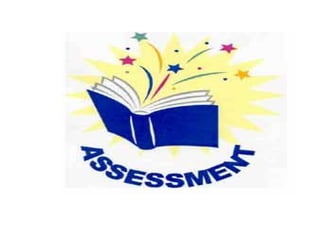2015 assessment new
- 4. SUMMATIVE vs FORMATIVE âĒ Kind of measurement done at the end of a stage. âĒ Ongoing feedback given during the course so as to improve performance.
- 5. SUMMATIVE vs FORMATIVE âĒ End of unit tests âĒ End of year tests âĒ Exams âĒ Diagnostic tests âĒ Asking and answering questions orally. âĒ Result analysis.
- 6. DIFFERENT TYPES OF TESTING âĒ PLACEMENT TEST âĒ DIAGNOSTIC TESTS âĒ PROGRESS OR ACHIEVEMENT TESTS âĒ PROFICIENCY TESTS
- 7. PORTFOLIO ASSESSMENT(FORMATIVE) âĒ It provides evidence of studentâs effort âĒ It helps students become more autonomous. âĒ It fosters studentsâ reflections âĒ It helps them selfmonitoring
- 8. CHARACTERISTICS OF A GOOD TEST - VALIDITY: it tests awhat it hs to test - RELIABILITY: it gives consistent results
- 9. TYPES OF TEST ITEM âĒ DIRECT âĒ Stsâgeneral or specialist knowledge. âĒ Create a âlevel- playing fieldâ. âĒ Replicate real-life interaction. âĒ eg. âtell me about your last holidaysâ âĒ INDIRECT âĒ Multiple choice questions. âĒ Cloze procedure. âĒ Transformation and paraphrase. âĒ Sentence re-ordering. âĒ eg. â Conjugate the verbs into the past tenseâ.
- 10. WRITING AND MARKING TESTS BEFORE: Assess the test situation: Which context? How much time? When? Where? Decide what to test: what to include. items. Balance the elements: Direct and indirect test Weight the scores: Give marks for each activity. Make the test work: Rehearse/try the test with another teacher
- 11. AFTER: Marking tests: Discuss criteria with colleagues. Training (for marking). -More than one scorer (if possible). -Global assessment scales (rubrics for oral and writing skills planned together). Analytic profiles: -reliable marking. -practicality -rubrics for oral/writing skills. Scoring and interacting during test: with team work done by a pair of teachers (one provokes conversation while the other one marks).
- 12. TEACHING FOR TESTS âWASHBACK OR BACKWASH EFFECTâ The format of the exam is determining the format of the lessons.
- 13. WHAT TO DO, STEPS âĒ TRAIN THE STS. FOR TEST TYPES: SO AS TO MAKE THEM FAMILIAR WITH THE TEST ITEMS THEY WILL HAVE TO FACE. âĒ DISCUSS GENERAL EXAM SKILLS: PACE/TIMING. âĒ DO PRACTICE TESTS:REHEARSALS/MOCKS âĒ HAVE FUN: PRACTICE GAMES AND ACTIVITIES âĒ IGNORE THE TEST: USE FREE ACTIVITIES FROM TIME TO TIME.
- 14. From âThe practice of English Language Teachingâ by Jeremy Harmer; chapter 22. Alicia PÃĐrez and Lorena Fleitas. Didactics III 2015














